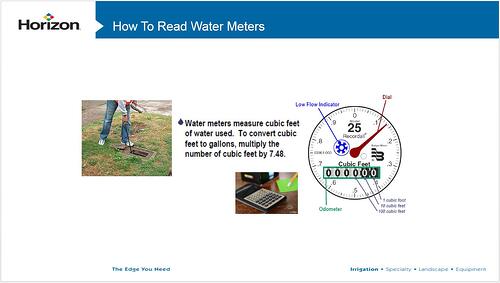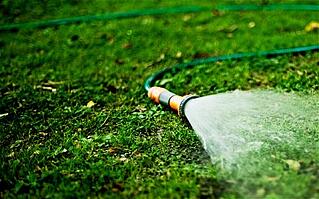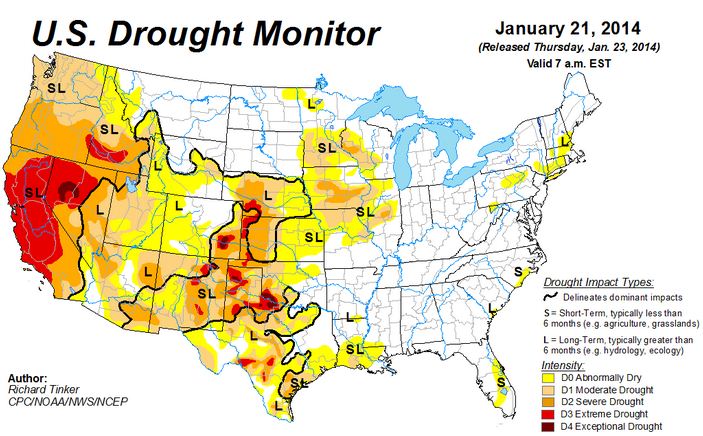The water meter is an overlooked tool that can help you quickly determine if there's a leak in your customer's irrigation system.
In Part 1 of our Drought Solutions video series, Bob Franchetto, DBDS Maintenance & Construction, shows you how the water meter can help you find and correct leaks.
Video Transcript
Who's been in their water meter, residential or commercial, in the last 30 days?
3, 4....good. That's awesome because we get almost next to nothing when I get a raise of hands. I'm glad you're in your water meters because first off you gotta know where it is on the site and what it is.

That's a huge, huge indicator of what we've got going on and we don't really care about this dial. If this dial here is moving on you, we've got a big leak.
What you wanna look at is this little flow indicator here. This little dial. Sometimes it's blue, sometimes it's a red triangle.
If that flow indicator is moving and we have the irrigation system shut off, we've got a main line break, we've got a leaky valve, we've got all kinds of other things to go.
This is the number one tool on our irrigation sites that gets overlooked. I ask, "What's the water meter doing?"
Man, I don't even know where the water meter is. Clunk, clunk, clunk you go. You know, cause it's buried. They finally find it, you dig it up and sure enough, there's a water meter there.
How are we checking our totals? Your customer is screaming that we are using too much water. Do a monthly check. See what your total is when you're there at the beginning of the month. Go back one month later. See what your total is then.
Do the math between the two numbers. That's how much water you used. Cubic feet or U.S. gallons is how that number is usually read and it will say on the dial right there. Then check your water bill for that site.
Our government agencies are doing averages like crazy. They will take your peak average and reduce it or increase it depending on where they think our temperatures have been.
Now a lot of them now have data recorders on them to where it will electronically send that data to the machine that the guys have. So he never even opens it up.
Is the Water Meter Leaking?
Check to see if your water meter is leaking. If your water meter is leaking on the city side, you're not going to see it. If your water meter is leaking on your side of the property, huge amounts of water that you're gonna pay for and your water meters are leaking.
I run into that. Dude, that's leaking on the city side. You're not getting billed for it, but we're wasting water. Let's get that fixed. It's a city responsibility.
When it starts leaking on your side, that's your responsibility as a property manager. And that happens a lot, so keep an eye on it.
Simple little tool. It's for the low hanging fruit. This is where we could tell what our leaks are in our system and our irrigation techs don't go look at that. Very, very seldom.
How to Check for Leaks
We went through this a little bit. The water meter is running. We see that little blue dial moving out. With the irrigation system turned off, that means the leak is between our meter and our valves. So now on that mainline piece that's supposed to be solid, no leaks. We got a leak in there.
If the backflow is turned off. That's a question. How many backflow prevention devices do we use? Commercial's got everything? Do we use any backflow in residential? Some?
I know we use a lot of anti-siphon valves. Above ground anti-siphon valve - huge opportunity for low hanging fruit right there.
If the backflow is turned off, now we just isolated - we're not the valves anymore, now we're back to the backflow - and we're still leaking, now we know it's on our main that's going from that meter to that main.
If water is running out of the heads on a flat surface, we've got a weeping valve. That valve is leaking. We know that. Let's go and replace and fix that valve. That's the next step into making sure that that is corrected. This is the stuff that gets missed every day.
And then if we've got a slope surface and we've got water running out the heads at the bottom of the slope, that's low head drainage. If there's no check valves in those sprinkler heads, every single time that system shuts off, every bit of water from the valve all the way down to the head in that pipe is gonna leak out. Every single time.
And we're going to do an ROI calculator to show you how much water you can save by putting a check valve in and capturing that water in the pipe so it doesn't run out every time.
So we're being great water purveyors, we're saying "Yeah, you know what I did? I cycle and soak my slopes because I get the water on the slope and it soaks in and then the system shuts off."
If you don't have a check valve in that head, everything that you're cycle and soaking trying to get in the ground just ran out of your pipe and it looks like this:

This is low head drainage right here. Classic. And you know what's so classic about this low head drainage right here and probably this misadjusted sprinkler head right here?
The classic thing about that is your irrigators go driving by that every single day. I know I see it every day. I see it every day on sites. Water on the street, water on the sidewalk, water in the gutters.
And we drive by it and our irrigation tech goes,"Yeah! Irrigation system watered today. Right on! Perfect!"
No, that's not the idea. That's not a visual indicator that the system came on. That's wasted water. That's low hanging fruit.
That's why we need to get in there and look at these kind of things.
It's the stuff we walk by every single day and don't pay attention to is where that 20% savings can come from and it will be way bigger than 20% savings because I've done the math enough times now to know that the numbers will save you water immediately just by corrective actions on this.


 As irrigation and landscape professionals, you know the benefits of using smart water products - reduction in water usage, healthier soil, lower water bills.
As irrigation and landscape professionals, you know the benefits of using smart water products - reduction in water usage, healthier soil, lower water bills.

